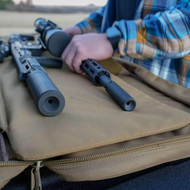How to Fix Common Suppressor Problems
Oct 28th 2024
Suppressors are invaluable tools for reducing firearm noise and enhancing shooting comfort, but like any firearm accessory, they can encounter issues. Whether it’s a misalignment, cleaning difficulty, or performance drop, understanding how to troubleshoot these problems can save you time, money, and frustration. This guide walks you through fixing common suppressor problems to keep your equipment in top condition.
1. Misalignment
Symptoms:
- Bullets clipping the suppressor’s internal baffles.
- Visible impact marks on the suppressor body or muzzle device.
- Shots deviating unexpectedly from their expected point of impact.
Causes:
- Improper mounting or loose suppressor threads.
- Damaged or poorly machined threads on the firearm or suppressor.
- Misaligned third-party mounts or adapters.
Fix:
- Check Thread Engagement: Ensure the suppressor threads fully onto the barrel without resistance.
- Inspect Muzzle Devices: If using a quick-detach (QD) system or muzzle device, verify its alignment using a bore alignment rod.
- Torque Correctly: For direct-thread suppressors, hand-tighten or use a torque wrench as recommended by the manufacturer (e.g., 25 ft/lbs for Echo Zulu Defense suppressors).
- Replace Faulty Components: Damaged threads or mounts should be replaced immediately.
2. Suppressor Stuck on the Barrel
Symptoms:
- Suppressor cannot be removed after shooting.
- Excessive force is required to unthread the suppressor.
Causes:
- Heat expansion causing threads to seize.
- Lack of anti-seize compound during installation.
- Residual carbon buildup in the threads.
Fix:
- Let It Cool: Allow the suppressor to cool completely before attempting removal.
- Use a Spanner Wrench: Tools like Echo Zulu Defense’s spanner wrench can provide extra leverage.
- Apply Penetrating Oil: Use a non-corrosive penetrating oil to loosen seized threads.
- Prevent Future Issues: Apply a small amount of anti-seize compound to the threads before installation.
3. Increased Noise or Reduced Performance
Symptoms:
- Louder-than-usual gunfire despite using the suppressor.
- Noticeable drop in sound suppression effectiveness.
Causes:
- Carbon buildup restricting gas flow.
- Damaged or eroded internal baffles.
- Suppressor mounted incorrectly.
Fix:
- Clean Thoroughly: Soak or ultrasonic clean the suppressor using a diluted Simple Green solution (1:4 ratio) or a carbon remover like Slip 2000.
- Inspect for Damage: Check for baffle deformation or erosion. If damaged, contact the manufacturer for repair or replacement.
- Remount Correctly: Verify the suppressor is securely mounted and aligned.
4. Difficulty Cleaning
Symptoms:
- Carbon deposits are difficult to remove.
- Residue buildup inside the suppressor persists after cleaning.
Causes:
- Using improper cleaning solutions or tools.
- Allowing fouling to harden by delaying cleaning.
Fix:
- Soak or Ultrasonic Clean: Use a recommended cleaning solution like diluted Simple Green or specialty carbon removers. Run the suppressor through a 15–20 minute ultrasonic cleaning cycle or soak for 24 hours.
- Avoid Abrasive Tools: Use nylon brushes and plastic picks to clean internal surfaces without damaging coatings like DLC or hBN.
- Adopt Regular Cleaning Habits: Clean rimfire suppressors every 500–1,000 rounds and centerfire suppressors every 2,500 rounds.
5. Thread Wear or Damage
Symptoms:
- Suppressor wobbles or feels loose when mounted.
- Threads appear stripped or uneven.
Causes:
- Cross-threading during installation.
- Excessive force applied when mounting or removing.
- Poorly machined threads on the barrel or suppressor.
Fix:
- Inspect Threads: Check for wear or damage on both the suppressor and firearm.
- Repair or Replace: Replace damaged mounts or seek professional thread repair for your barrel or suppressor.
- Prevent Future Issues: Always thread the suppressor on slowly and carefully. Use anti-seize compound to reduce wear.
6. Overheating
Symptoms:
- Excessive heat buildup during shooting.
- Visible discoloration or wear on the suppressor exterior.
Causes:
- Sustained rapid-fire or full-auto use without cooling intervals.
- Exceeding material heat thresholds (e.g., 900°F for titanium suppressors).
Fix:
- Cool Down: Allow the suppressor to cool between extended firing sessions. Follow manufacturer recommendations for cooldown periods (e.g., 10 minutes after 90 rounds for the Echo Zulu X1R556-Ti).
- Monitor Temperature: Use an infrared thermometer to track suppressor temperature during high-volume shooting.
- Upgrade Materials: If rapid-fire shooting is common, consider a suppressor made from heat-resistant materials like Inconel.
7. Coating Wear
Symptoms:
- Outer coating shows scratches, discoloration, or flaking.
- Internal surfaces exhibit carbon buildup despite cleaning.
Causes:
- Abrasive cleaning methods.
- Prolonged exposure to extreme heat or chemical cleaners.
Fix:
- Clean Gently: Use non-abrasive tools and solutions to avoid damaging coatings like DLC or hBN.
- Avoid Harsh Chemicals: Do not use ammonia-based cleaners or acidic solutions.
- Contact Manufacturer: If coatings degrade significantly, consult the manufacturer for possible repair or recoating options.
Preventing Suppressor Problems
- Follow Manufacturer Guidelines: Always adhere to recommended maintenance and usage instructions.
- Use Proper Ammunition: Stick to SAAMI or CIP-compliant ammo to avoid excess fouling or pressure-related issues.
- Inspect Regularly: Check threads, baffles, and coatings periodically to catch issues early.
- Store Properly: Keep your suppressor dry and secure to prevent environmental damage.
Final Thoughts
Understanding and addressing common suppressor problems ensures your investment stays reliable and effective. By following these troubleshooting steps, you can prevent minor issues from becoming major headaches.
For more suppressor maintenance tips, visit our Maintenance Page or contact Echo Zulu Defense for personalized support.

